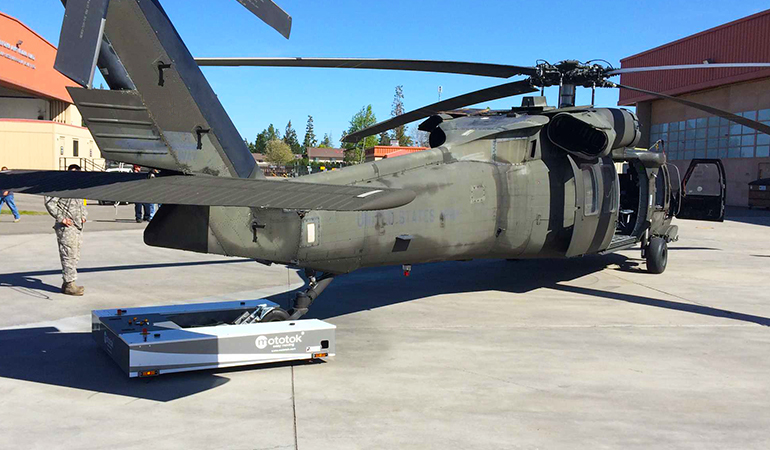Remotely operated and autonomous ground support equipment (GSE), particularly aircraft tugs, represent a valuable alternative to traditional units. Military users have long been users of traditional GSE, but does this hamper operational requirements and demands? We are taking a look at the potential benefits of military operations integrating remotely operated GSE into their ranks.
Why Make the Switch?
Unlike private sector aviation operations, military operations are often plagued by an inability to quickly acquire new equipment. When these organizations make a switch, it often affects large fleets of aircraft, rather than a single isolated operation.
Diesel powered GSE items, namely aircraft tugs, have worked quite well for a number of decades now. In fact, they have remained highly unchanged for many decades. Sure, the platforms have changed somewhat in concord with technology, mostly because it ends up using stock components from production vehicles. Why reinvent the wheel?
But there are some really good reasons to consider making the switch to remotely controlled tugs for your military airport operation, and here are a few:
#1: Manpower Constraints
This is by far the most consistent problem with all military operations over the Western World. Manpower is consistently an issue in military units; military operations necessitate this. Military aviation units cannot keep support functions overstaffed (“fat”) because the bulk of manpower inherently goes to the warfighters. This is just a reflection of big-picture manpower considerations which have very little to do with aviation support functions; warfighting requires that resources by funneled predominantly to the warfighter.
A typical military aircraft tug requires a driver, tow team supervisor, and wingwalkers. This takes valuable technicians away from other operations which are more technically demanding.
#2: Simplicity
Not meant as an insult, but simplicity reigns king in industrial operations. When so much of the job is highly technical, reducing the mental workload when and where you can is really important. It doesn’t get much easier than a remote control vehicle, which remotely operated tugs essentially share common control inputs as recreational R/C vehicles. There is essentially no learning curve in their operation other than mounting the aircraft to the tug.
#3: Cross Training
This may not make a lot of sense, but military ground maintenance and support entities rely on a mass-production model to produce a large amount of technicians in a short amount of time. So, unlike civilian technicians who are well versed in a variety of different areas of the aircraft, military technicians are trained in one specific area (electrical and environmental, avionics, engines, hydraulics, etc.). There is usually an airframe section which handles all general items on the aircraft, a general skill set, which includes mooring, engine run-ups, fueling and servicing, and, you guessed it, aircraft movement.
Technicians who are in specialized areas will not have the time to crosstrain to general items like refueling and aircraft towing. That being said, there are times when the generalists are too task-saturated to handle all of the work needing to be done, whereas there are ample specialist available for simpler tasks.
Cost Savings in Tangible Terms
Throwing around jargon about savings is easy, but putting in practical terms is a little tougher. So what exactly can a remote controlled tug provide the end user where it matters most?
It’s awfully tough to average out the length of an aircraft tow operation because there are so many variables. But for the sake of simplicity, let’s call it one hour from muster to finish. On a typical tow operation, you will have: a driver, a brake operator, tow team supervisor, and optionally wing walkers for each wing, and a tail observer when moving into and out of hangars. So at one working hour, multiplied by six team members, you are obligating six man hours for each towing operation. If you are conducting five tows per day, that is thirty man hours per day committed just to towing, although from personal experience the daily count of aircraft movements is probably five to six times the example of five.
So at 30 man hours per day, times five days in a work week (military air operations rarely see a five day workweek) is 150 man hours per week tied up in the simple chore of aircraft movement.
So, let’s take this a step farther. An engine change on an aircraft takes between 50-100 man hours to complete, depending on aircraft type, conditions, skill level of technicians, etc. Think about it this way: by removing one individual off of tow operations for a week, you have now freed up 25 man hours to do something else. This could be half of an engine change.
Removing two technicians for a tow now saves you enough man hours to conduct and entire engine change.
So let’s dive even deeper into this line of thought. Each position of a tow operation is going to be obligated for 1,300 man hours per year! Now we are looking at a lot of work which can be done each year by reallocating a single position from average towing team operations.
What exactly does an additional 1,300 hours get you? It gets you anywhere between 13 and 26 engine changes! What else can in essentially ‘buy’? In a zero-sum world where we can assume technicians are capable of myriad functions to include engine work, and aircraft maintenance checks, let’s have a look.
Air carrier maintenance standards fairly mimic those of military operations, so the ABC check system can reasonably be transposed to military tasks with a complementary understanding of the nomenclature.
- ‘A’ checks are the most basic inspection cycle, which are conducted every 200-300 flight hours. ‘A’ checks are considered line maintenance so there is no need for heavy scaffolding, hangar space, etc. These checks are to the tune of 50-70 man hours, so the savings of two tow-team members for one week of work buys an ‘A’ check inspection.
- ‘B’ checks are more in-depth, generally built on the isochronal concept of every 6-8 months. These are going to run somewhere in the ballpark of 160-180 man hours. Relieving a tow team of two members by using remote control tugs will purchase a ‘B’ check in a little over 3 ½ weeks. Relieving a single tow team member for a year will get your organization over eight ‘B’ checks.
- ‘C’ checks are getting pretty in-depth and are conducted around every two years, or a predetermined flight hour schedule. ‘C’ checks usually take a couple of weeks, and significant hangar space for scaffolding, heavy lifts, aircraft jacking, etc. ‘C’ checks are going to run about 6,000 man hours, which is significant; however, if you can relieve two tow team members for a year, you just opened up around 2,600 man hours per years which were tied up in moving aircraft. That is nearly half of a ‘C’ check!
Real, Turn-Key Savings
So, we have taken a look at how much manpower you could potentially save by reallocating your most valuable resource: people. But are the savings actually there to be gleaned from something as simple as towing aircraft? YES.
In the U.S. Air Force, the same career field which refuels aircraft and tows aircraft, per their formal position description, is the same career field which conducts isochronal and phase inspections (‘B’ and ‘C’ checks, essentially). On fighter aircraft, this same career field also conducts engine removals and installations, auxiliary power unit removals and replacements, hydraulic system troubleshooting and repairs. On all airframes, this career field is responsible for tire buildups, aircraft control rigging, and even crashed aircraft recovery! So yes, if you can reduce the man hours these individuals are doing menial servicing work, the more you are freeing up for technical work.
The aircraft tow team can be highly reduced by the use of a remote control tug; the supervisor is also the driver. He can move to any position of the tow to include wingtips or tail, so at a minimum you can remove two positions. But commands may be willing to remove any more since the supervisor can slow down the process and roam the perimeter of the aircraft to observe any potential hazards. With training and time, they may remove all wingtip and tail walkers, along with a driver, which would then leave a demand for only two team members! By this metric, you may save 3,200 man hours per year in your military operation, and that is a conservative estimate. Just by minimizing a simple task and using modern tools which are at your fingertips already.
Conclusion on remotely operated GSE in the military
Manpower is consistently the most highly desired and yet unattainable asset in all military operations, of which aviation is not an anomaly. By simply making the shift from old technology to new, you can immediately reap the benefits of highly enhanced manpower availability without adding a single person to the staff. This has the potential to be a real force multiplier across the scope of an entire aviation branch of service. All because of simple savings in one small niche of the grand scheme of military aviation operations.
For more know-how on aviation, ground handling and co. just sign up to our blog –
for free!



Comments